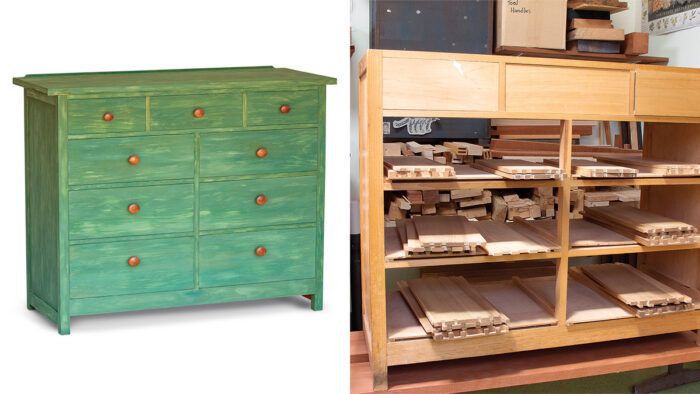From the Bench: A long loose end
A nine-drawer dresser sat in mid-build for nearly 30 years, its drawers half-built, its pockets stuffed with student supplies, clippings, letters, and other stuff. Then David Welter retired, and the dresser came home, rose to the top of the "to-do" list, and found a new life.
Synopsis: Born in the early days of David Welter’s career at The Krenov School, a nine-drawer dresser sat in mid-build for nearly 30 years, its drawers half-built, its pockets stuffed with student supplies, clippings, letters, and other stuff. Then David retired, and the dresser came home, rose to the top of the “to-do” list, and found a new life.
In 1988, I was a freshly employed instructional aide in a woodworking school with a well-appointed shop. Surely I’d have time after hours to build a useful piece of furniture for our home. The particleboard dresser in use was an embarrassment, particularly given my choice of vocation.
The nine-drawer dresser of my dreams would be a solid piece of utility, at home in a farmhouse. It would be coated with milk paint, the practical nature of the finish harmonizing nicely with the form. Even the materials would be utilitarian. Poplar, the primary wood, takes paint well; firm but not hard, it resists splitting and is fun to plane. The side panels would be maple plywood and the drawer frames maple.
Nothing would be spared in construction techniques. I’d use the shop’s best practices plus a few details gleaned from Charles H. Hayward’s Woodwork Joints: a dovetailed carcase joint tying the sides together at the top frame, and halved joints at the intersection of the drawer blades and the center divider.
Work went well at the beginning. But school duties had a way of intruding on lunchtime work, and after hours time was claimed by the demands of putting an addition on our house. Shortly after the new bedroom was completed, a Deco chest of drawers came our way, removing the last bit of urgency to complete the project.
Make Your Own Spokeshave
Former Krenov School instructor David Welter demonstrates
how to make a wooden spokeshave that will quickly become one
of your favorite hand tools.
At that point the carcase was complete but the top was not glued up; the pins of all of the drawer front dovetails were done and the top three drawers were in and functioning, though lacking pulls. Remaining parts were stored in the pockets that the completed drawers would occupy. And so the incomplete dresser obstructed entrance to my small cubbyhole of a workspace for the next 27 years, serving to stash student supplies, clippings, letters, and objects of indefinite classification. The top was not always clear, but there was always space for a coffee cup. Even in its incomplete state, it served a utilitarian purpose.
The incomplete dresser obstructed entrance to my small cubbyhole of a workspace for the next 27 years, serving to stash student supplies, clippings, letters, and objects of indefinite classification.
When my time at the school was done, my companion was the last of my possessions to leave. Now my focus was on building a shop and guest room in our back yard. The unfinished dresser went to a spare bedroom.
The shop was functional a year after the footings were poured. Eventually, excuses exhausted, it was time to bestow upon the old dray horse her intended glory. Reorientation took a bit; questioning why I did something that way, then begrudgingly admitting there was some sense to the choice. I did see fault in my dovetail layout. Maybe someone will notice someday that at the back of the drawers the pattern changes halfway down and wonder why. A couple of the drawer fronts had cupped a little; as the dovetails were done, there was little to do but count on the joinery to pull the front flat—a moderately effective plan. Really, all that needed to be done was to finish dovetailing, assemble and fit the drawers, make some pulls, glue up a top, clean up the carcase, and deal with the greatest obstacle: choosing a paint color.
My farmhouse dresser has an admitted Shaker character. Looking for drawer-pull guidance, I noticed that Shaker pulls were usually round, equally sized, and vertically centered on drawer fronts. Having spent so much time with James Krenov, I find dead-centered focal points to be exactly that—dead. I fashioned oval pulls from a cherry tree cut down to make room for my shop. Sized in proportion to the drawer size, the pulls are variously positioned for the sake of the user, adding a bit of liveliness to the cabinet face.
The humble witness to nearly my entire school shop career has re-emerged in our home, carrying the first chapters of a hopefully long tale of life.
From Fine Woodworking #289
From the Bench: Woodworking changed my life
From the bench: What is a mentor?
From the Bench: The problem with passion
Fine Woodworking Recommended Products

Dividers

Stanley Powerlock 16-ft. tape measure

Drafting Tools




























Comments
Long time spend there and hope you missed that time which spent in to office with this bench, taken the lunch, files work and so many things. Hope you have wonderful experienced!
Log in or create an account to post a comment.
Sign up Log in